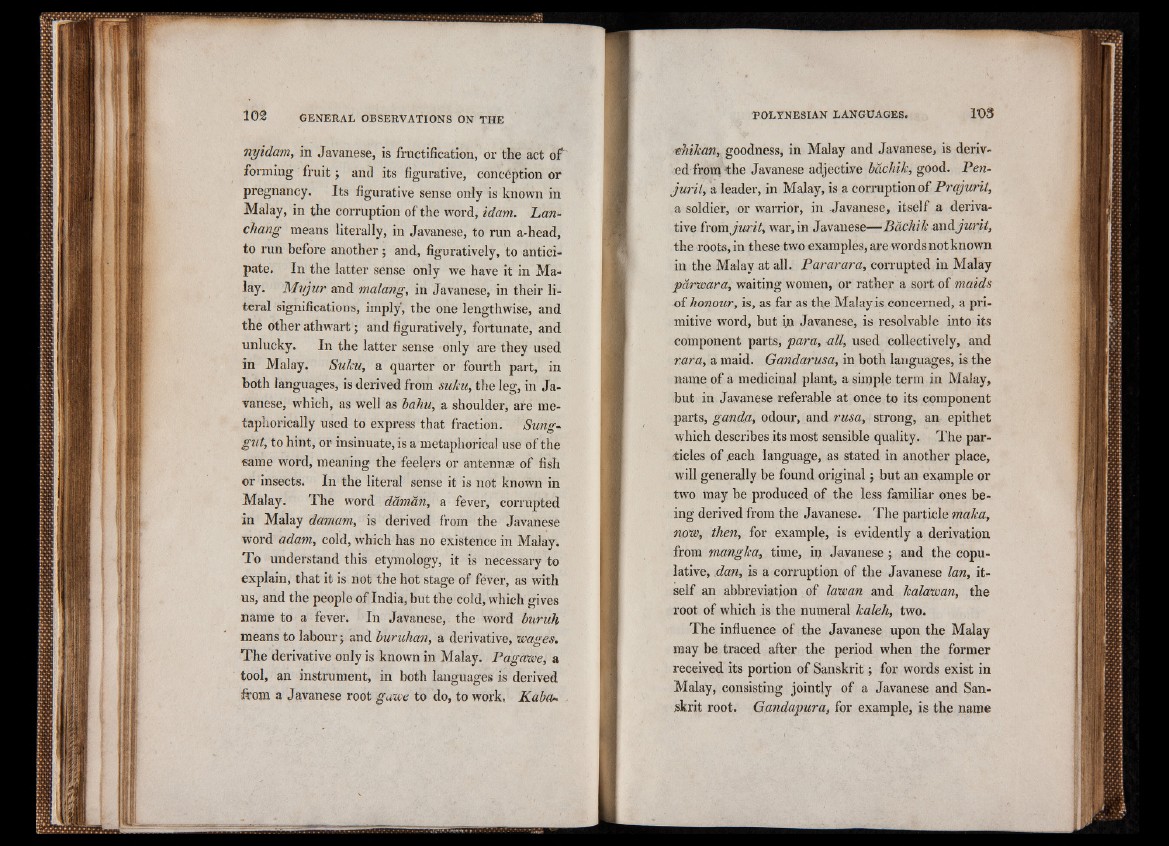
nyidam, in Javanese, is fructification, or the act of
forming fruit j and its figurative, conception or
pregnancy. Its figurative sense only is known in
Malay, in the corruption of the word, idam. Lan-
chang means literally, in Javanese, to run a-head,
to run before another; and, figuratively, to anticipate.
In the latter sense only we have it in Malay.
Mitjur and malang, in Javanese, in their literal
significations, imply, the one lengthwise, and
the other athwart; and figuratively, fortunate, and
unlucky. In the latter sense only are they used
in Malay. Suku, a quarter or fourth part, in
both languages, is derived from suku, the leg, in Javanese,
which, as well as bahu, a shoulder, are metaphorically
used to express that fraction. Sung-
gut, to hint, or insinuate, is a metaphorical use of the
same word, meaning the feelers or antenna; of fish
or insects. In the literal sense it is not known in
Malay. The word daman, a fever, corrupted
in Malay damam, is derived from the Javanese
word adam, cold, which has no existence in Malay.
To understand this etymology, it is necessary to
explain, that it is not the hot stage of fever, as with
us, and the people of India, but the cold, which gives
name to a fever. In Javanese,, the word buruh
means to labour 5 and buruhan, a derivative, wages.
The derivative only is known in Malay. Pagawe, a
tool, an instrument, in both languages is derived
from a Javanese root gawe to do, to work, Kaba*
trhiJcan, goodness, in Malay and Javanese, is derived
from'the Javanese adjective bdchik, good. Pen-
jurit, a leader, in Malay, is a corruption of Prajurit,
a soldier, or warrior, in Javanese, itself a derivative
from jurit, war, in Javanese—Bdchik and jurit,
the roots, in these two examples, are words not known
in the Malay at all. Pararara, corrupted in Malay
pdrwara, waiting women, or rather a sort of maids
of honour, is, as far as the Malay is concerned, a primitive
word, but in Javanese, is resolvable into its
component parts, para, all, used collectively, and
r.ara, a maid. Gandarusa, in both languages, is the
name of a medicinal plant, a simple term in Malay,
but in Javanese referable at once to its component
parts, ganda, odour, and rusa, strong, an epithet
which describes its most sensible quality. The particles
of .each language, as stated in another place,
will generally be found original; but an example or
two may be produced of the less familiar ones being
derived from the Javanese. The particle maka,
now, then, for example, is evidently a derivation
from mangka, time, in Javanese; and the copulative,
dan, is a corruption of the Javanese lan, itself
an abbreviation of lawan and kalawan, the
root of which is the numeral kaleh, two.
The influence of the Javanese upon the Malay
may be traced after the period when the former
received its portion of Sanskrit; for words exist in
Malay, consisting jointly of a Javanese and Sanskrit
root. Gandapura, for example, is the name